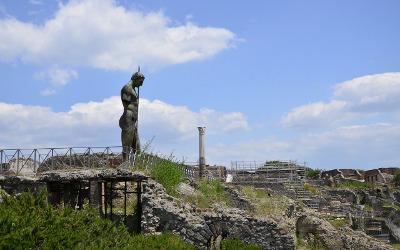OU researcher recognises the significance of ancient river system on Mars

An Open University (OU) researcher has made new discoveries about the ancient martian environment through a detailed study of an ancient river system on Mars.
Running water on the oldest regions of Mars
In a paper published in the Journal of Geophysical Research: Planets, Dr Matt Balme, Senior Lecturer in the OU’s Faculty of Science, Technology, Engineering and Mathematics, lead author, has identified the significance of a series of branching and stacked sinuous ridges, deposited by running water on the oldest regions of Mars.
Dr Balme and an international team of collaborators used high‐resolution satellite images to investigate “Aram Dorsum,” an 85 km long ridge system in the Arabia Terra region. Their observations show that Aram Dorsum is composed of sedimentary rocks, originally deposited in rivers or their adjacent floodplains. The thickness of the sediments suggests that the Aram Dorsum river system was active for between 10,000 and 10 million years.
Formed around 3.9 billion years ago
The study also indicates that Aram Dorsum was formed around 3.9 billion years ago, an age consistent with other evidence for ancient rivers and lakes in this region. The water that flowed within the rivers at Aram Dorsum probably came from both locally and regionally generated rainfall or snowfall, rather than a single point source of water, such as large distant ice sheets. These observations therefore point to an ancient Martian climate that supported precipitation and river flow for thousands or millions of years.
Dr Balme said:
“This Martian ridge feature – “Aram Dorsum” – was once a large river system. It’s one of the oldest examples we have of rivers on Mars, and shows that rain, or maybe snow melt, produced large amounts of flowing water here at this time. These flows could have persisted, on and off, for thousand or millions of years.”
Semi-finalist in ExoMars Rover site selection
Dr Balme had spotted the Aram Dorsam ridge in lower resolution data in previous research and had proposed it as an ESA ExoMars “Rosalind Franklin” Rover landing site. The site made it to the “semi-final” in ExoMars Rover site selection, but was eventually ruled out in favour of Mawrth Vallis or Oxia Planum (Oxia was the final chosen site).
“The combination of lots of water and long-lived water activity are what make this such a good site for a “search for life” rover mission. Plus, after the rivers became inactive, this area was buried by later deposits and remained so for much of Mars’s history. It was only re-exposed relatively recently. This burial helps to preserve any signs of life there might have been,” Dr Balme concludes.
Quarterly Review of Research
Read our Quarterly Review of Research to learn about our latest quality academic output.

Contact our news team
For all out of hours enquiries, please telephone +44 (0)7901 515891
